Evaluating Incentives and Obstacles for DSM Strategies in the UK
VerifiedAdded on 2023/01/18
|15
|3505
|43
Report
AI Summary
This report critically analyzes Demand Side Management (DSM) strategies, focusing on Demand Side Response, Distributed Generation, and Demand Reduction within the United Kingdom. It examines the incentives and obstacles influencing the implementation of these strategies, considering technological, institutional, financial, and policy factors. The analysis delves into the residential energy demand, exploring energy efficiency measures and the role of distributed generation. The report highlights obstacles such as lack of awareness, contract limitations, and policy gaps impacting the effectiveness of DSM programs. Furthermore, it investigates the trends and potential for demand reduction, identifying barriers to energy efficiency improvements. The report provides a comprehensive overview of the UK's energy landscape, offering insights into the challenges and opportunities associated with DSM strategies.
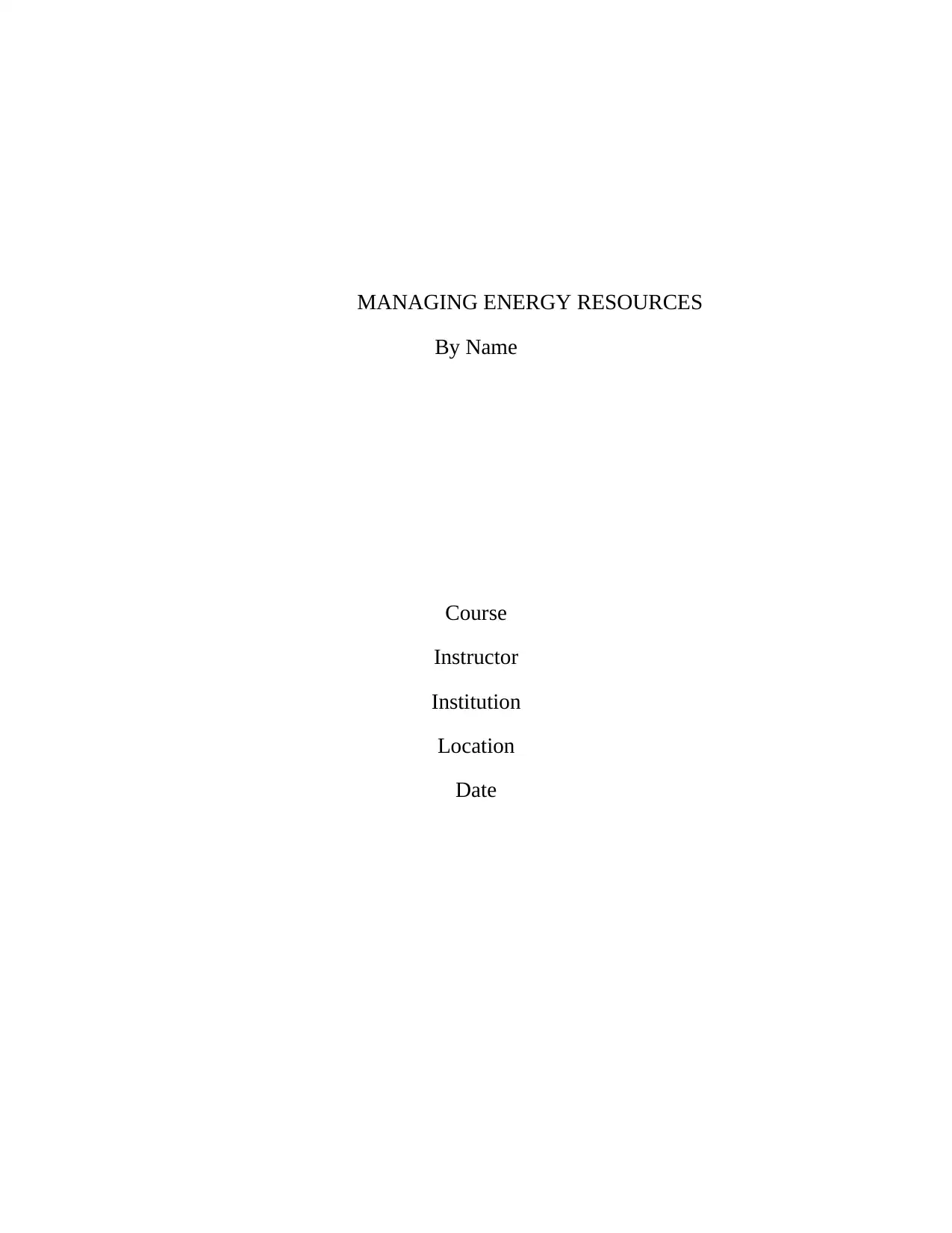
MANAGING ENERGY RESOURCES
By Name
Course
Instructor
Institution
Location
Date
By Name
Course
Instructor
Institution
Location
Date
Paraphrase This Document
Need a fresh take? Get an instant paraphrase of this document with our AI Paraphraser
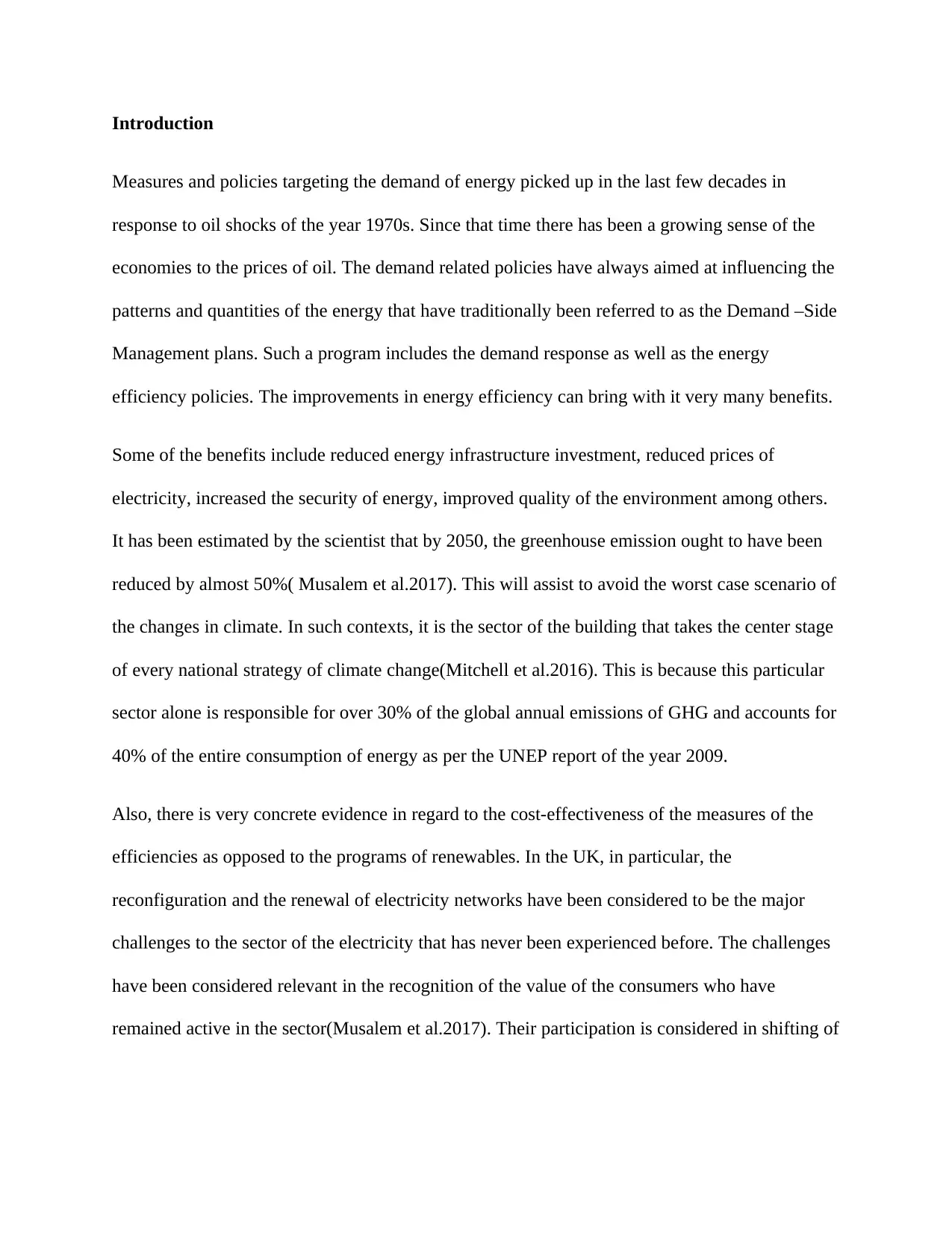
Introduction
Measures and policies targeting the demand of energy picked up in the last few decades in
response to oil shocks of the year 1970s. Since that time there has been a growing sense of the
economies to the prices of oil. The demand related policies have always aimed at influencing the
patterns and quantities of the energy that have traditionally been referred to as the Demand –Side
Management plans. Such a program includes the demand response as well as the energy
efficiency policies. The improvements in energy efficiency can bring with it very many benefits.
Some of the benefits include reduced energy infrastructure investment, reduced prices of
electricity, increased the security of energy, improved quality of the environment among others.
It has been estimated by the scientist that by 2050, the greenhouse emission ought to have been
reduced by almost 50%( Musalem et al.2017). This will assist to avoid the worst case scenario of
the changes in climate. In such contexts, it is the sector of the building that takes the center stage
of every national strategy of climate change(Mitchell et al.2016). This is because this particular
sector alone is responsible for over 30% of the global annual emissions of GHG and accounts for
40% of the entire consumption of energy as per the UNEP report of the year 2009.
Also, there is very concrete evidence in regard to the cost-effectiveness of the measures of the
efficiencies as opposed to the programs of renewables. In the UK, in particular, the
reconfiguration and the renewal of electricity networks have been considered to be the major
challenges to the sector of the electricity that has never been experienced before. The challenges
have been considered relevant in the recognition of the value of the consumers who have
remained active in the sector(Musalem et al.2017). Their participation is considered in shifting of
Measures and policies targeting the demand of energy picked up in the last few decades in
response to oil shocks of the year 1970s. Since that time there has been a growing sense of the
economies to the prices of oil. The demand related policies have always aimed at influencing the
patterns and quantities of the energy that have traditionally been referred to as the Demand –Side
Management plans. Such a program includes the demand response as well as the energy
efficiency policies. The improvements in energy efficiency can bring with it very many benefits.
Some of the benefits include reduced energy infrastructure investment, reduced prices of
electricity, increased the security of energy, improved quality of the environment among others.
It has been estimated by the scientist that by 2050, the greenhouse emission ought to have been
reduced by almost 50%( Musalem et al.2017). This will assist to avoid the worst case scenario of
the changes in climate. In such contexts, it is the sector of the building that takes the center stage
of every national strategy of climate change(Mitchell et al.2016). This is because this particular
sector alone is responsible for over 30% of the global annual emissions of GHG and accounts for
40% of the entire consumption of energy as per the UNEP report of the year 2009.
Also, there is very concrete evidence in regard to the cost-effectiveness of the measures of the
efficiencies as opposed to the programs of renewables. In the UK, in particular, the
reconfiguration and the renewal of electricity networks have been considered to be the major
challenges to the sector of the electricity that has never been experienced before. The challenges
have been considered relevant in the recognition of the value of the consumers who have
remained active in the sector(Musalem et al.2017). Their participation is considered in shifting of
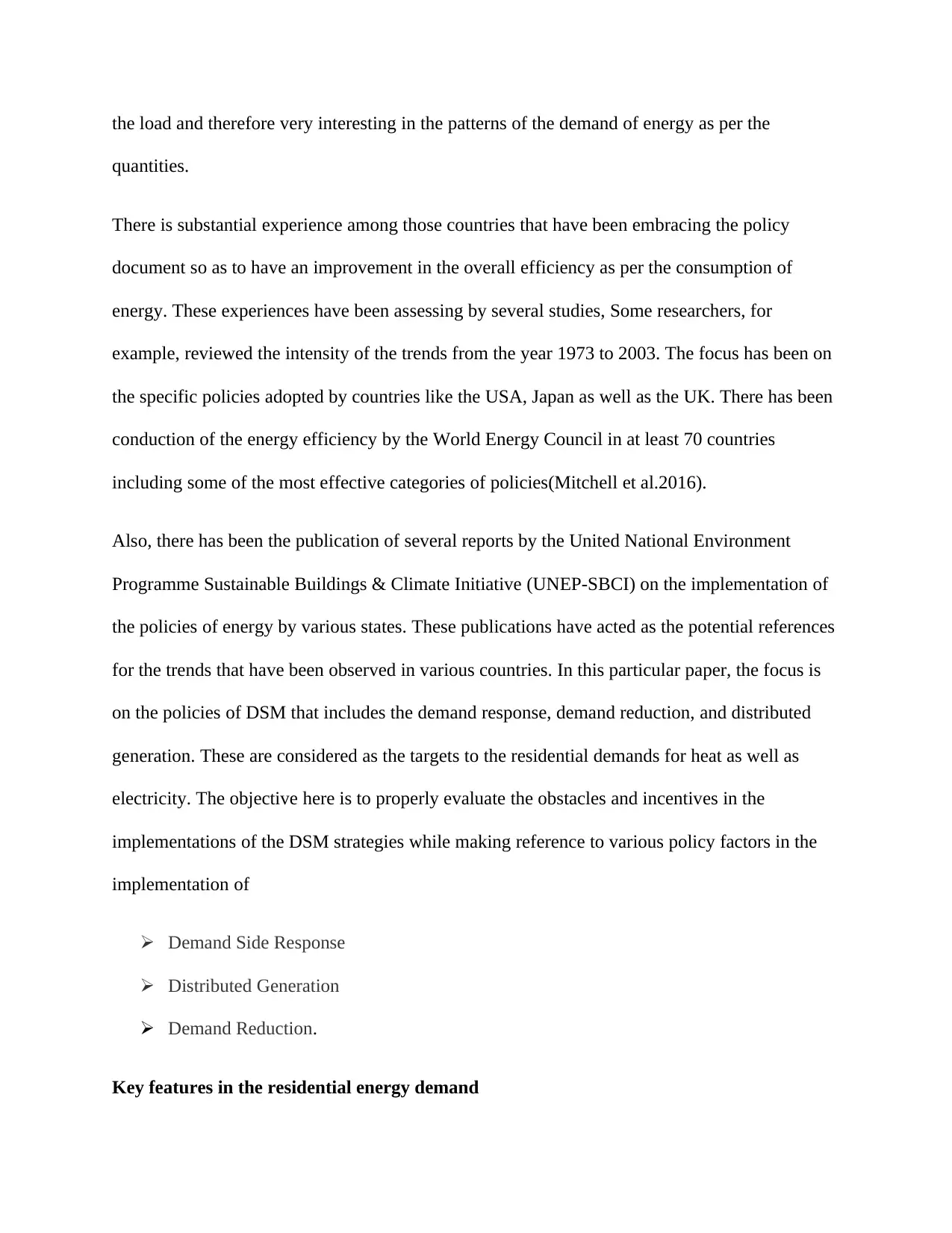
the load and therefore very interesting in the patterns of the demand of energy as per the
quantities.
There is substantial experience among those countries that have been embracing the policy
document so as to have an improvement in the overall efficiency as per the consumption of
energy. These experiences have been assessing by several studies, Some researchers, for
example, reviewed the intensity of the trends from the year 1973 to 2003. The focus has been on
the specific policies adopted by countries like the USA, Japan as well as the UK. There has been
conduction of the energy efficiency by the World Energy Council in at least 70 countries
including some of the most effective categories of policies(Mitchell et al.2016).
Also, there has been the publication of several reports by the United National Environment
Programme Sustainable Buildings & Climate Initiative (UNEP-SBCI) on the implementation of
the policies of energy by various states. These publications have acted as the potential references
for the trends that have been observed in various countries. In this particular paper, the focus is
on the policies of DSM that includes the demand response, demand reduction, and distributed
generation. These are considered as the targets to the residential demands for heat as well as
electricity. The objective here is to properly evaluate the obstacles and incentives in the
implementations of the DSM strategies while making reference to various policy factors in the
implementation of
Demand Side Response
Distributed Generation
Demand Reduction.
Key features in the residential energy demand
quantities.
There is substantial experience among those countries that have been embracing the policy
document so as to have an improvement in the overall efficiency as per the consumption of
energy. These experiences have been assessing by several studies, Some researchers, for
example, reviewed the intensity of the trends from the year 1973 to 2003. The focus has been on
the specific policies adopted by countries like the USA, Japan as well as the UK. There has been
conduction of the energy efficiency by the World Energy Council in at least 70 countries
including some of the most effective categories of policies(Mitchell et al.2016).
Also, there has been the publication of several reports by the United National Environment
Programme Sustainable Buildings & Climate Initiative (UNEP-SBCI) on the implementation of
the policies of energy by various states. These publications have acted as the potential references
for the trends that have been observed in various countries. In this particular paper, the focus is
on the policies of DSM that includes the demand response, demand reduction, and distributed
generation. These are considered as the targets to the residential demands for heat as well as
electricity. The objective here is to properly evaluate the obstacles and incentives in the
implementations of the DSM strategies while making reference to various policy factors in the
implementation of
Demand Side Response
Distributed Generation
Demand Reduction.
Key features in the residential energy demand
⊘ This is a preview!⊘
Do you want full access?
Subscribe today to unlock all pages.

Trusted by 1+ million students worldwide
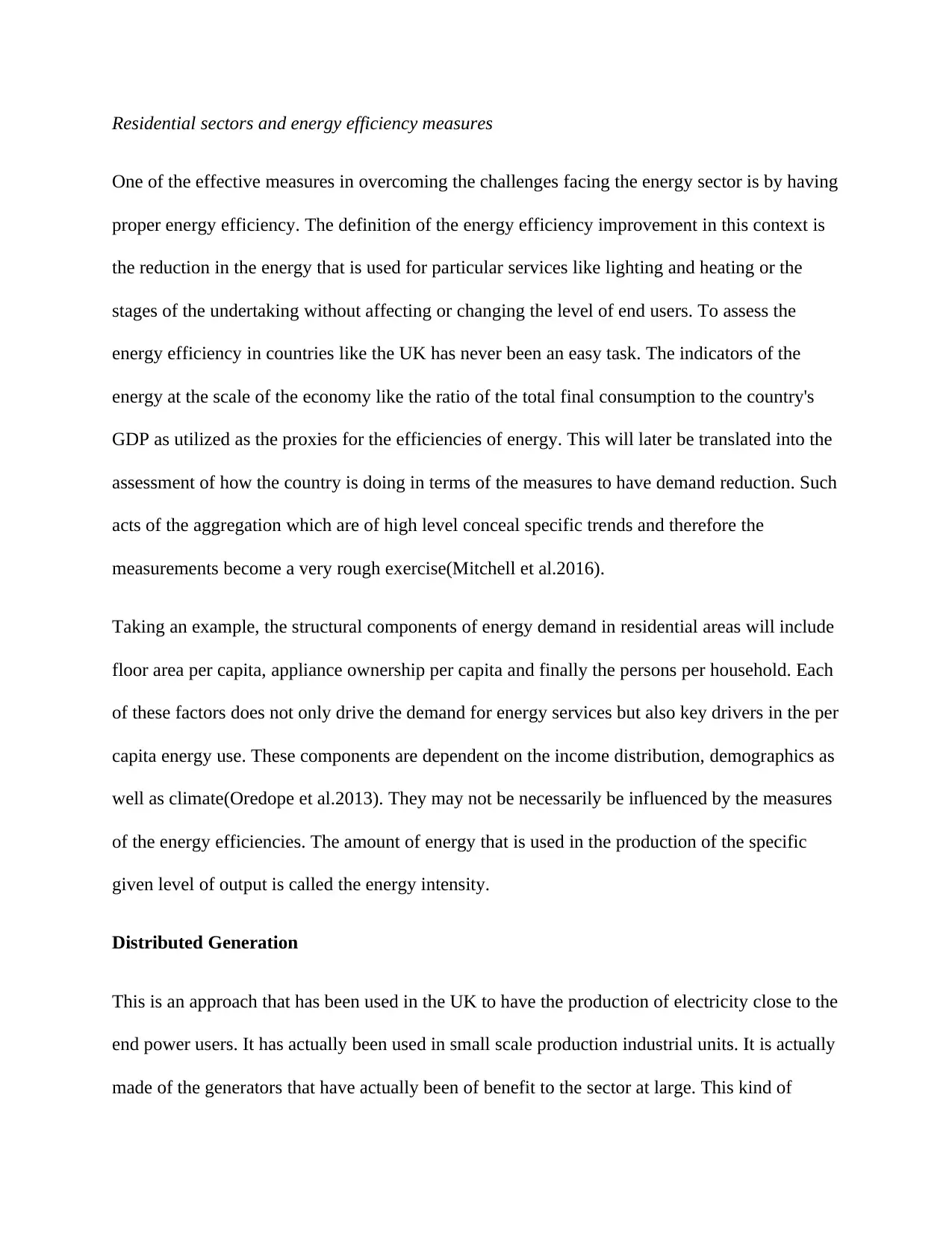
Residential sectors and energy efficiency measures
One of the effective measures in overcoming the challenges facing the energy sector is by having
proper energy efficiency. The definition of the energy efficiency improvement in this context is
the reduction in the energy that is used for particular services like lighting and heating or the
stages of the undertaking without affecting or changing the level of end users. To assess the
energy efficiency in countries like the UK has never been an easy task. The indicators of the
energy at the scale of the economy like the ratio of the total final consumption to the country's
GDP as utilized as the proxies for the efficiencies of energy. This will later be translated into the
assessment of how the country is doing in terms of the measures to have demand reduction. Such
acts of the aggregation which are of high level conceal specific trends and therefore the
measurements become a very rough exercise(Mitchell et al.2016).
Taking an example, the structural components of energy demand in residential areas will include
floor area per capita, appliance ownership per capita and finally the persons per household. Each
of these factors does not only drive the demand for energy services but also key drivers in the per
capita energy use. These components are dependent on the income distribution, demographics as
well as climate(Oredope et al.2013). They may not be necessarily be influenced by the measures
of the energy efficiencies. The amount of energy that is used in the production of the specific
given level of output is called the energy intensity.
Distributed Generation
This is an approach that has been used in the UK to have the production of electricity close to the
end power users. It has actually been used in small scale production industrial units. It is actually
made of the generators that have actually been of benefit to the sector at large. This kind of
One of the effective measures in overcoming the challenges facing the energy sector is by having
proper energy efficiency. The definition of the energy efficiency improvement in this context is
the reduction in the energy that is used for particular services like lighting and heating or the
stages of the undertaking without affecting or changing the level of end users. To assess the
energy efficiency in countries like the UK has never been an easy task. The indicators of the
energy at the scale of the economy like the ratio of the total final consumption to the country's
GDP as utilized as the proxies for the efficiencies of energy. This will later be translated into the
assessment of how the country is doing in terms of the measures to have demand reduction. Such
acts of the aggregation which are of high level conceal specific trends and therefore the
measurements become a very rough exercise(Mitchell et al.2016).
Taking an example, the structural components of energy demand in residential areas will include
floor area per capita, appliance ownership per capita and finally the persons per household. Each
of these factors does not only drive the demand for energy services but also key drivers in the per
capita energy use. These components are dependent on the income distribution, demographics as
well as climate(Oredope et al.2013). They may not be necessarily be influenced by the measures
of the energy efficiencies. The amount of energy that is used in the production of the specific
given level of output is called the energy intensity.
Distributed Generation
This is an approach that has been used in the UK to have the production of electricity close to the
end power users. It has actually been used in small scale production industrial units. It is actually
made of the generators that have actually been of benefit to the sector at large. This kind of
Paraphrase This Document
Need a fresh take? Get an instant paraphrase of this document with our AI Paraphraser

approach takes place at two levels that are the endpoint level and the local level. The local level
has included the use of renewable sources of energy like wind turbines and solar systems. The
endpoint level applies to the individual energy as evident in the modular internal combustion
engine. Its measurement is in terms of the quantity of the energy required for the performance of
a particular task. In the residential sectors, the measurement of the intensity of the energy can be
done in terms of the household per capitated energy intensity is reduced with increased energy
efficiency. This is explained by the changes in the structures like the household number as well
as an increase in the number of appliances. All of these factors have a gradual offset effect on the
improvement of the efficiency of energy through insulation as well as heating(Mitchell et
al.2016).
Demand Side Response
The demand side response has been considered as for how the electricity is utilized rather than
how it is generated. When the total demand of the electricity in the entire the UK goes high, the
consumers are linked to the Great British Bake Off final. During this period, electricity can be
used more intelligently rather than just having a mere system of generation. Such initiatives may
include having supermarkets switching of their fridges. As well as factories delaying their
intensive processes that demand a lot of power. The turning to the performance in these sectors
in terms of the policies, the studies of the ex-post is normally hard to find. They are not publicly
available(Mitchell et al.2016).
They are not just in existence but if they do then they face challenges due to the shortage of the
data and variation in the methods of the evaluation, verification and measurement protocol. It is
difficult for a consensus to be established in terms of the quantification of the auxiliary benefits
has included the use of renewable sources of energy like wind turbines and solar systems. The
endpoint level applies to the individual energy as evident in the modular internal combustion
engine. Its measurement is in terms of the quantity of the energy required for the performance of
a particular task. In the residential sectors, the measurement of the intensity of the energy can be
done in terms of the household per capitated energy intensity is reduced with increased energy
efficiency. This is explained by the changes in the structures like the household number as well
as an increase in the number of appliances. All of these factors have a gradual offset effect on the
improvement of the efficiency of energy through insulation as well as heating(Mitchell et
al.2016).
Demand Side Response
The demand side response has been considered as for how the electricity is utilized rather than
how it is generated. When the total demand of the electricity in the entire the UK goes high, the
consumers are linked to the Great British Bake Off final. During this period, electricity can be
used more intelligently rather than just having a mere system of generation. Such initiatives may
include having supermarkets switching of their fridges. As well as factories delaying their
intensive processes that demand a lot of power. The turning to the performance in these sectors
in terms of the policies, the studies of the ex-post is normally hard to find. They are not publicly
available(Mitchell et al.2016).
They are not just in existence but if they do then they face challenges due to the shortage of the
data and variation in the methods of the evaluation, verification and measurement protocol. It is
difficult for a consensus to be established in terms of the quantification of the auxiliary benefits
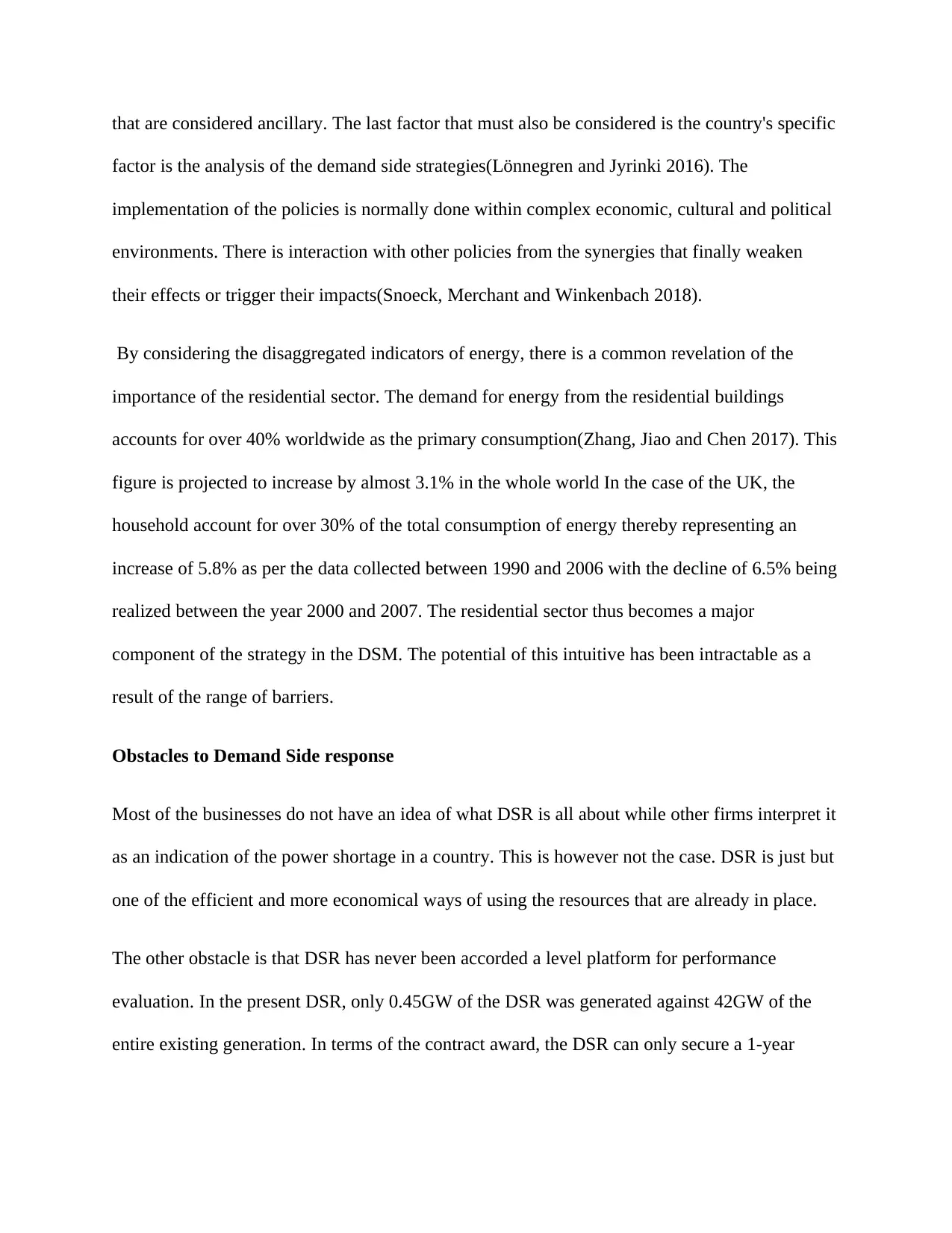
that are considered ancillary. The last factor that must also be considered is the country's specific
factor is the analysis of the demand side strategies(Lönnegren and Jyrinki 2016). The
implementation of the policies is normally done within complex economic, cultural and political
environments. There is interaction with other policies from the synergies that finally weaken
their effects or trigger their impacts(Snoeck, Merchant and Winkenbach 2018).
By considering the disaggregated indicators of energy, there is a common revelation of the
importance of the residential sector. The demand for energy from the residential buildings
accounts for over 40% worldwide as the primary consumption(Zhang, Jiao and Chen 2017). This
figure is projected to increase by almost 3.1% in the whole world In the case of the UK, the
household account for over 30% of the total consumption of energy thereby representing an
increase of 5.8% as per the data collected between 1990 and 2006 with the decline of 6.5% being
realized between the year 2000 and 2007. The residential sector thus becomes a major
component of the strategy in the DSM. The potential of this intuitive has been intractable as a
result of the range of barriers.
Obstacles to Demand Side response
Most of the businesses do not have an idea of what DSR is all about while other firms interpret it
as an indication of the power shortage in a country. This is however not the case. DSR is just but
one of the efficient and more economical ways of using the resources that are already in place.
The other obstacle is that DSR has never been accorded a level platform for performance
evaluation. In the present DSR, only 0.45GW of the DSR was generated against 42GW of the
entire existing generation. In terms of the contract award, the DSR can only secure a 1-year
factor is the analysis of the demand side strategies(Lönnegren and Jyrinki 2016). The
implementation of the policies is normally done within complex economic, cultural and political
environments. There is interaction with other policies from the synergies that finally weaken
their effects or trigger their impacts(Snoeck, Merchant and Winkenbach 2018).
By considering the disaggregated indicators of energy, there is a common revelation of the
importance of the residential sector. The demand for energy from the residential buildings
accounts for over 40% worldwide as the primary consumption(Zhang, Jiao and Chen 2017). This
figure is projected to increase by almost 3.1% in the whole world In the case of the UK, the
household account for over 30% of the total consumption of energy thereby representing an
increase of 5.8% as per the data collected between 1990 and 2006 with the decline of 6.5% being
realized between the year 2000 and 2007. The residential sector thus becomes a major
component of the strategy in the DSM. The potential of this intuitive has been intractable as a
result of the range of barriers.
Obstacles to Demand Side response
Most of the businesses do not have an idea of what DSR is all about while other firms interpret it
as an indication of the power shortage in a country. This is however not the case. DSR is just but
one of the efficient and more economical ways of using the resources that are already in place.
The other obstacle is that DSR has never been accorded a level platform for performance
evaluation. In the present DSR, only 0.45GW of the DSR was generated against 42GW of the
entire existing generation. In terms of the contract award, the DSR can only secure a 1-year
⊘ This is a preview!⊘
Do you want full access?
Subscribe today to unlock all pages.

Trusted by 1+ million students worldwide
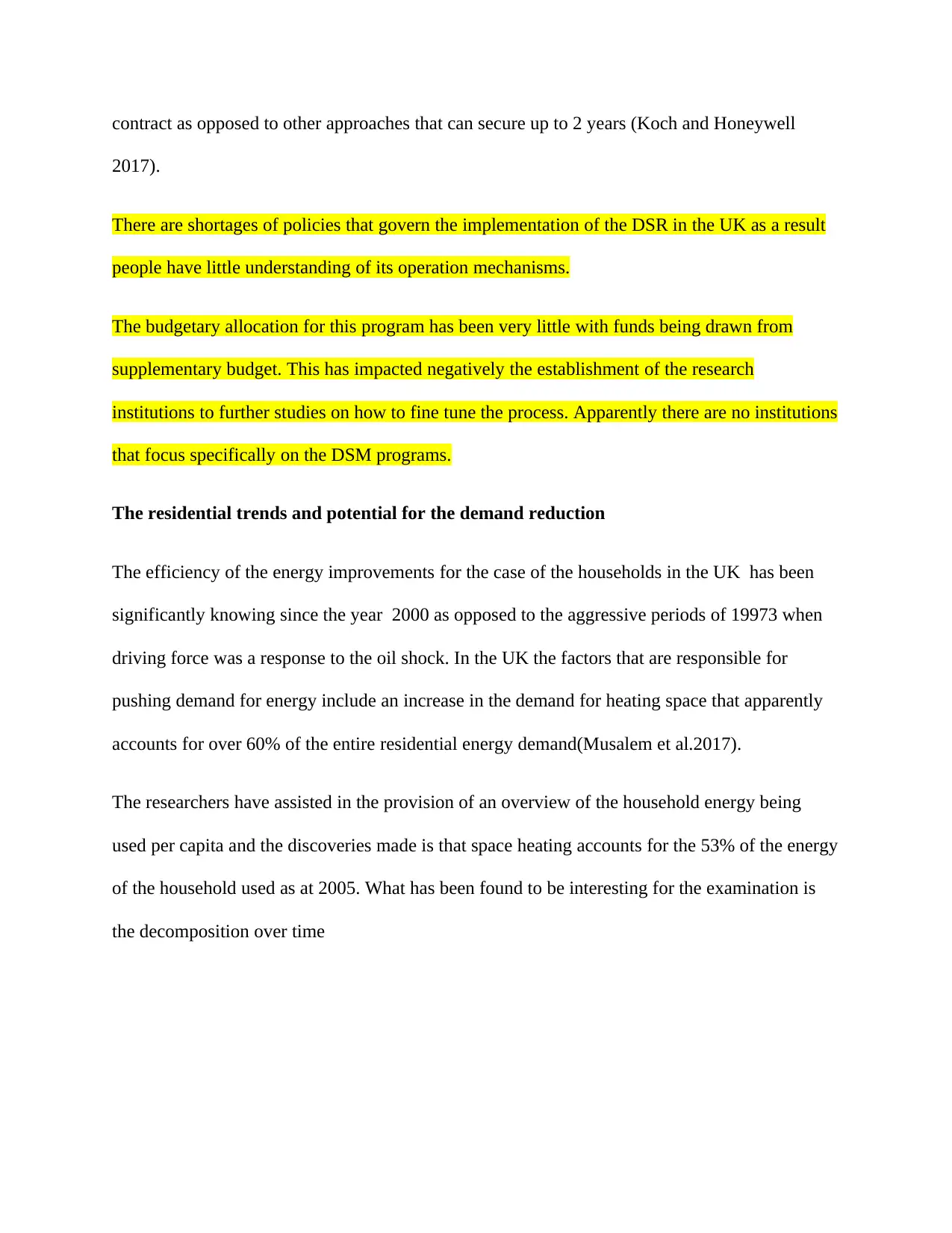
contract as opposed to other approaches that can secure up to 2 years (Koch and Honeywell
2017).
There are shortages of policies that govern the implementation of the DSR in the UK as a result
people have little understanding of its operation mechanisms.
The budgetary allocation for this program has been very little with funds being drawn from
supplementary budget. This has impacted negatively the establishment of the research
institutions to further studies on how to fine tune the process. Apparently there are no institutions
that focus specifically on the DSM programs.
The residential trends and potential for the demand reduction
The efficiency of the energy improvements for the case of the households in the UK has been
significantly knowing since the year 2000 as opposed to the aggressive periods of 19973 when
driving force was a response to the oil shock. In the UK the factors that are responsible for
pushing demand for energy include an increase in the demand for heating space that apparently
accounts for over 60% of the entire residential energy demand(Musalem et al.2017).
The researchers have assisted in the provision of an overview of the household energy being
used per capita and the discoveries made is that space heating accounts for the 53% of the energy
of the household used as at 2005. What has been found to be interesting for the examination is
the decomposition over time
2017).
There are shortages of policies that govern the implementation of the DSR in the UK as a result
people have little understanding of its operation mechanisms.
The budgetary allocation for this program has been very little with funds being drawn from
supplementary budget. This has impacted negatively the establishment of the research
institutions to further studies on how to fine tune the process. Apparently there are no institutions
that focus specifically on the DSM programs.
The residential trends and potential for the demand reduction
The efficiency of the energy improvements for the case of the households in the UK has been
significantly knowing since the year 2000 as opposed to the aggressive periods of 19973 when
driving force was a response to the oil shock. In the UK the factors that are responsible for
pushing demand for energy include an increase in the demand for heating space that apparently
accounts for over 60% of the entire residential energy demand(Musalem et al.2017).
The researchers have assisted in the provision of an overview of the household energy being
used per capita and the discoveries made is that space heating accounts for the 53% of the energy
of the household used as at 2005. What has been found to be interesting for the examination is
the decomposition over time
Paraphrase This Document
Need a fresh take? Get an instant paraphrase of this document with our AI Paraphraser
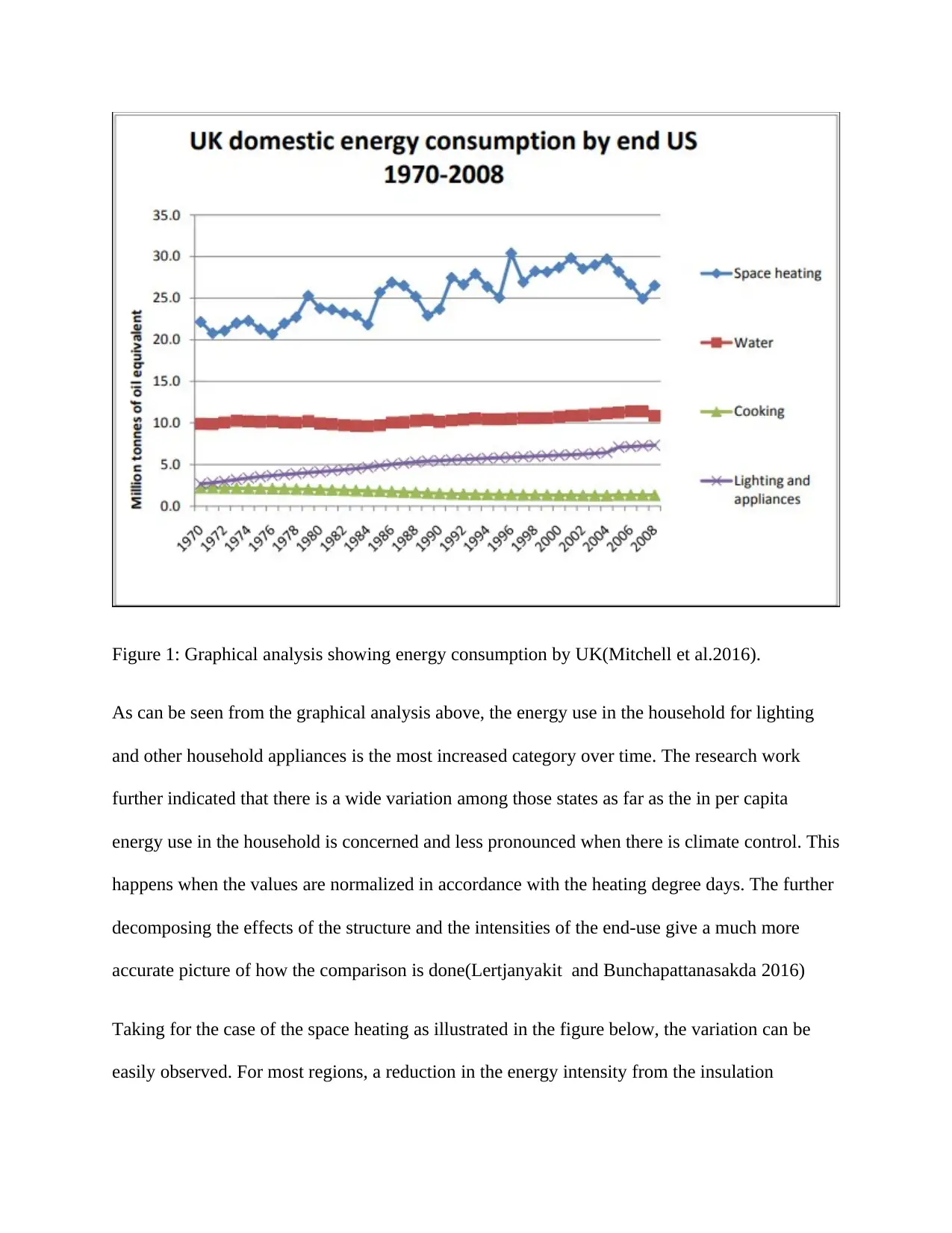
Figure 1: Graphical analysis showing energy consumption by UK(Mitchell et al.2016).
As can be seen from the graphical analysis above, the energy use in the household for lighting
and other household appliances is the most increased category over time. The research work
further indicated that there is a wide variation among those states as far as the in per capita
energy use in the household is concerned and less pronounced when there is climate control. This
happens when the values are normalized in accordance with the heating degree days. The further
decomposing the effects of the structure and the intensities of the end-use give a much more
accurate picture of how the comparison is done(Lertjanyakit and Bunchapattanasakda 2016)
Taking for the case of the space heating as illustrated in the figure below, the variation can be
easily observed. For most regions, a reduction in the energy intensity from the insulation
As can be seen from the graphical analysis above, the energy use in the household for lighting
and other household appliances is the most increased category over time. The research work
further indicated that there is a wide variation among those states as far as the in per capita
energy use in the household is concerned and less pronounced when there is climate control. This
happens when the values are normalized in accordance with the heating degree days. The further
decomposing the effects of the structure and the intensities of the end-use give a much more
accurate picture of how the comparison is done(Lertjanyakit and Bunchapattanasakda 2016)
Taking for the case of the space heating as illustrated in the figure below, the variation can be
easily observed. For most regions, a reduction in the energy intensity from the insulation
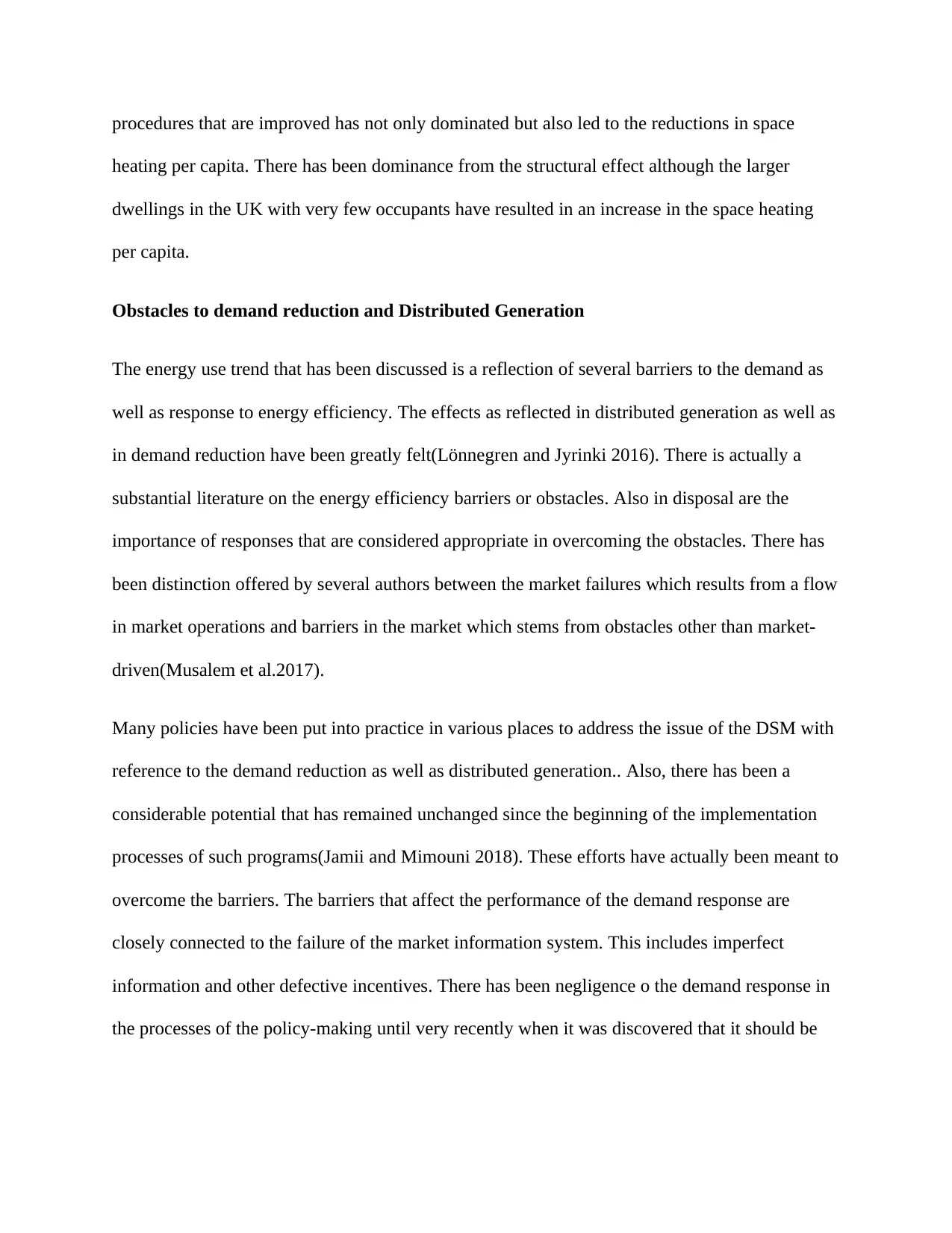
procedures that are improved has not only dominated but also led to the reductions in space
heating per capita. There has been dominance from the structural effect although the larger
dwellings in the UK with very few occupants have resulted in an increase in the space heating
per capita.
Obstacles to demand reduction and Distributed Generation
The energy use trend that has been discussed is a reflection of several barriers to the demand as
well as response to energy efficiency. The effects as reflected in distributed generation as well as
in demand reduction have been greatly felt(Lönnegren and Jyrinki 2016). There is actually a
substantial literature on the energy efficiency barriers or obstacles. Also in disposal are the
importance of responses that are considered appropriate in overcoming the obstacles. There has
been distinction offered by several authors between the market failures which results from a flow
in market operations and barriers in the market which stems from obstacles other than market-
driven(Musalem et al.2017).
Many policies have been put into practice in various places to address the issue of the DSM with
reference to the demand reduction as well as distributed generation.. Also, there has been a
considerable potential that has remained unchanged since the beginning of the implementation
processes of such programs(Jamii and Mimouni 2018). These efforts have actually been meant to
overcome the barriers. The barriers that affect the performance of the demand response are
closely connected to the failure of the market information system. This includes imperfect
information and other defective incentives. There has been negligence o the demand response in
the processes of the policy-making until very recently when it was discovered that it should be
heating per capita. There has been dominance from the structural effect although the larger
dwellings in the UK with very few occupants have resulted in an increase in the space heating
per capita.
Obstacles to demand reduction and Distributed Generation
The energy use trend that has been discussed is a reflection of several barriers to the demand as
well as response to energy efficiency. The effects as reflected in distributed generation as well as
in demand reduction have been greatly felt(Lönnegren and Jyrinki 2016). There is actually a
substantial literature on the energy efficiency barriers or obstacles. Also in disposal are the
importance of responses that are considered appropriate in overcoming the obstacles. There has
been distinction offered by several authors between the market failures which results from a flow
in market operations and barriers in the market which stems from obstacles other than market-
driven(Musalem et al.2017).
Many policies have been put into practice in various places to address the issue of the DSM with
reference to the demand reduction as well as distributed generation.. Also, there has been a
considerable potential that has remained unchanged since the beginning of the implementation
processes of such programs(Jamii and Mimouni 2018). These efforts have actually been meant to
overcome the barriers. The barriers that affect the performance of the demand response are
closely connected to the failure of the market information system. This includes imperfect
information and other defective incentives. There has been negligence o the demand response in
the processes of the policy-making until very recently when it was discovered that it should be
⊘ This is a preview!⊘
Do you want full access?
Subscribe today to unlock all pages.

Trusted by 1+ million students worldwide
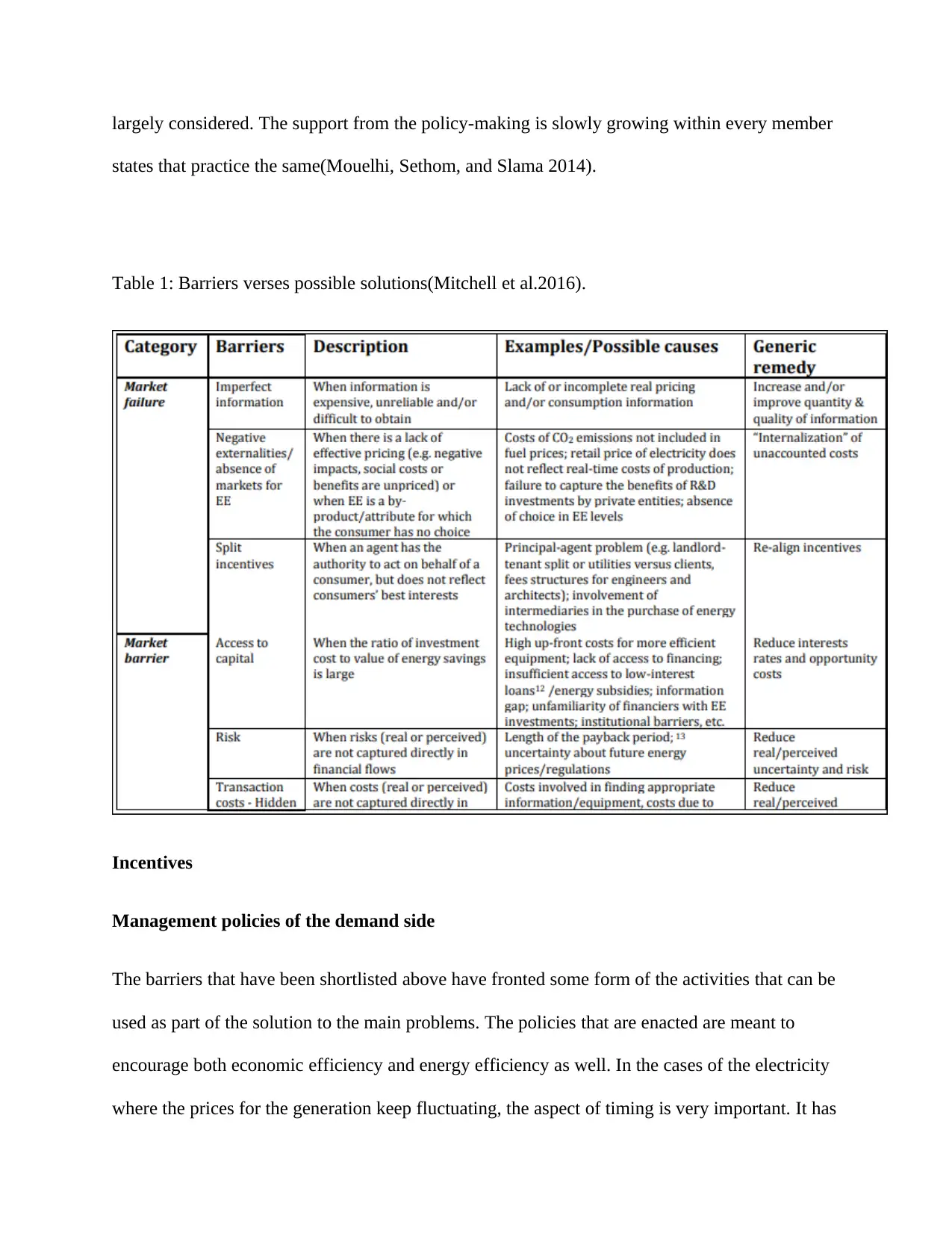
largely considered. The support from the policy-making is slowly growing within every member
states that practice the same(Mouelhi, Sethom, and Slama 2014).
Table 1: Barriers verses possible solutions(Mitchell et al.2016).
Incentives
Management policies of the demand side
The barriers that have been shortlisted above have fronted some form of the activities that can be
used as part of the solution to the main problems. The policies that are enacted are meant to
encourage both economic efficiency and energy efficiency as well. In the cases of the electricity
where the prices for the generation keep fluctuating, the aspect of timing is very important. It has
states that practice the same(Mouelhi, Sethom, and Slama 2014).
Table 1: Barriers verses possible solutions(Mitchell et al.2016).
Incentives
Management policies of the demand side
The barriers that have been shortlisted above have fronted some form of the activities that can be
used as part of the solution to the main problems. The policies that are enacted are meant to
encourage both economic efficiency and energy efficiency as well. In the cases of the electricity
where the prices for the generation keep fluctuating, the aspect of timing is very important. It has
Paraphrase This Document
Need a fresh take? Get an instant paraphrase of this document with our AI Paraphraser
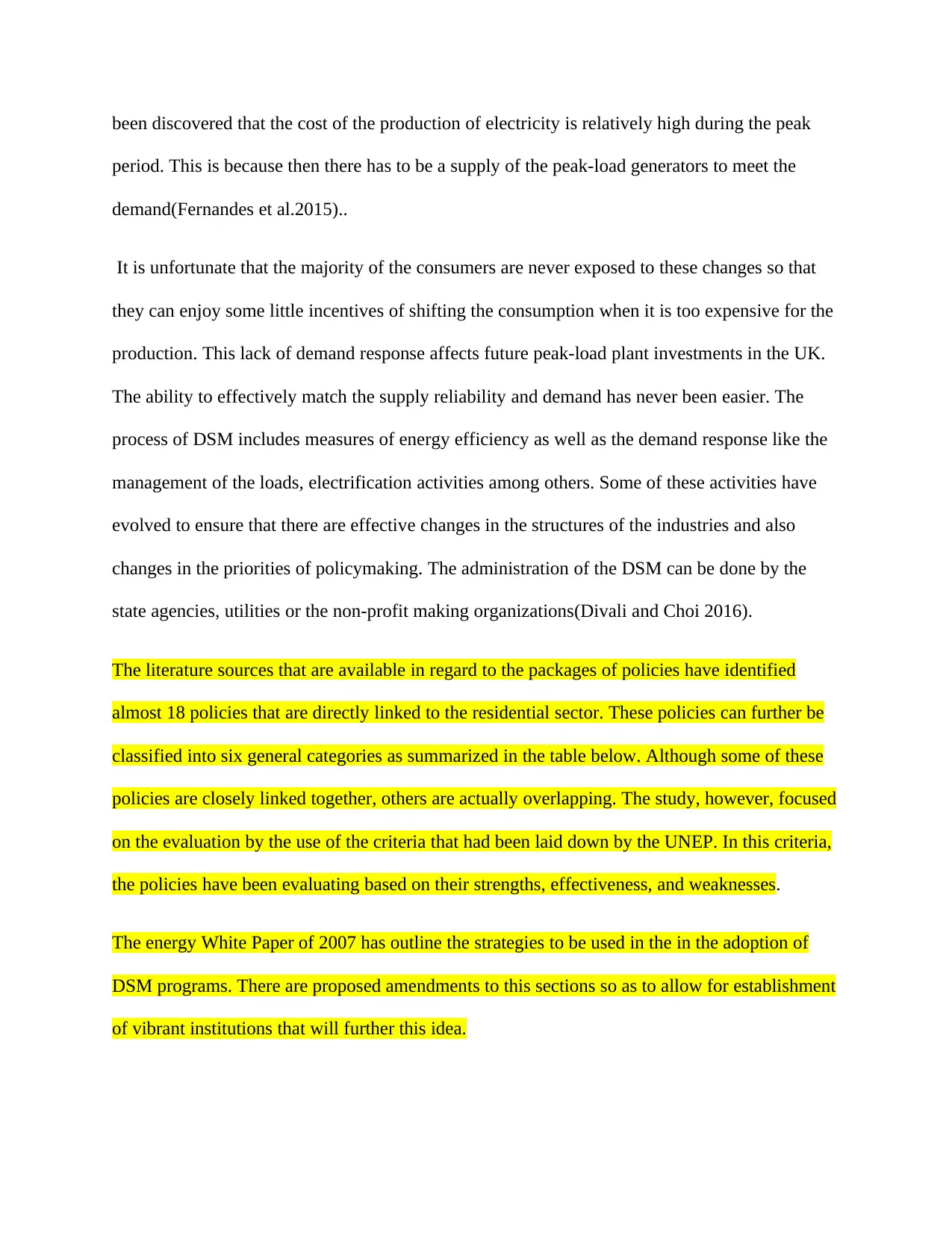
been discovered that the cost of the production of electricity is relatively high during the peak
period. This is because then there has to be a supply of the peak-load generators to meet the
demand(Fernandes et al.2015)..
It is unfortunate that the majority of the consumers are never exposed to these changes so that
they can enjoy some little incentives of shifting the consumption when it is too expensive for the
production. This lack of demand response affects future peak-load plant investments in the UK.
The ability to effectively match the supply reliability and demand has never been easier. The
process of DSM includes measures of energy efficiency as well as the demand response like the
management of the loads, electrification activities among others. Some of these activities have
evolved to ensure that there are effective changes in the structures of the industries and also
changes in the priorities of policymaking. The administration of the DSM can be done by the
state agencies, utilities or the non-profit making organizations(Divali and Choi 2016).
The literature sources that are available in regard to the packages of policies have identified
almost 18 policies that are directly linked to the residential sector. These policies can further be
classified into six general categories as summarized in the table below. Although some of these
policies are closely linked together, others are actually overlapping. The study, however, focused
on the evaluation by the use of the criteria that had been laid down by the UNEP. In this criteria,
the policies have been evaluating based on their strengths, effectiveness, and weaknesses.
The energy White Paper of 2007 has outline the strategies to be used in the in the adoption of
DSM programs. There are proposed amendments to this sections so as to allow for establishment
of vibrant institutions that will further this idea.
period. This is because then there has to be a supply of the peak-load generators to meet the
demand(Fernandes et al.2015)..
It is unfortunate that the majority of the consumers are never exposed to these changes so that
they can enjoy some little incentives of shifting the consumption when it is too expensive for the
production. This lack of demand response affects future peak-load plant investments in the UK.
The ability to effectively match the supply reliability and demand has never been easier. The
process of DSM includes measures of energy efficiency as well as the demand response like the
management of the loads, electrification activities among others. Some of these activities have
evolved to ensure that there are effective changes in the structures of the industries and also
changes in the priorities of policymaking. The administration of the DSM can be done by the
state agencies, utilities or the non-profit making organizations(Divali and Choi 2016).
The literature sources that are available in regard to the packages of policies have identified
almost 18 policies that are directly linked to the residential sector. These policies can further be
classified into six general categories as summarized in the table below. Although some of these
policies are closely linked together, others are actually overlapping. The study, however, focused
on the evaluation by the use of the criteria that had been laid down by the UNEP. In this criteria,
the policies have been evaluating based on their strengths, effectiveness, and weaknesses.
The energy White Paper of 2007 has outline the strategies to be used in the in the adoption of
DSM programs. There are proposed amendments to this sections so as to allow for establishment
of vibrant institutions that will further this idea.
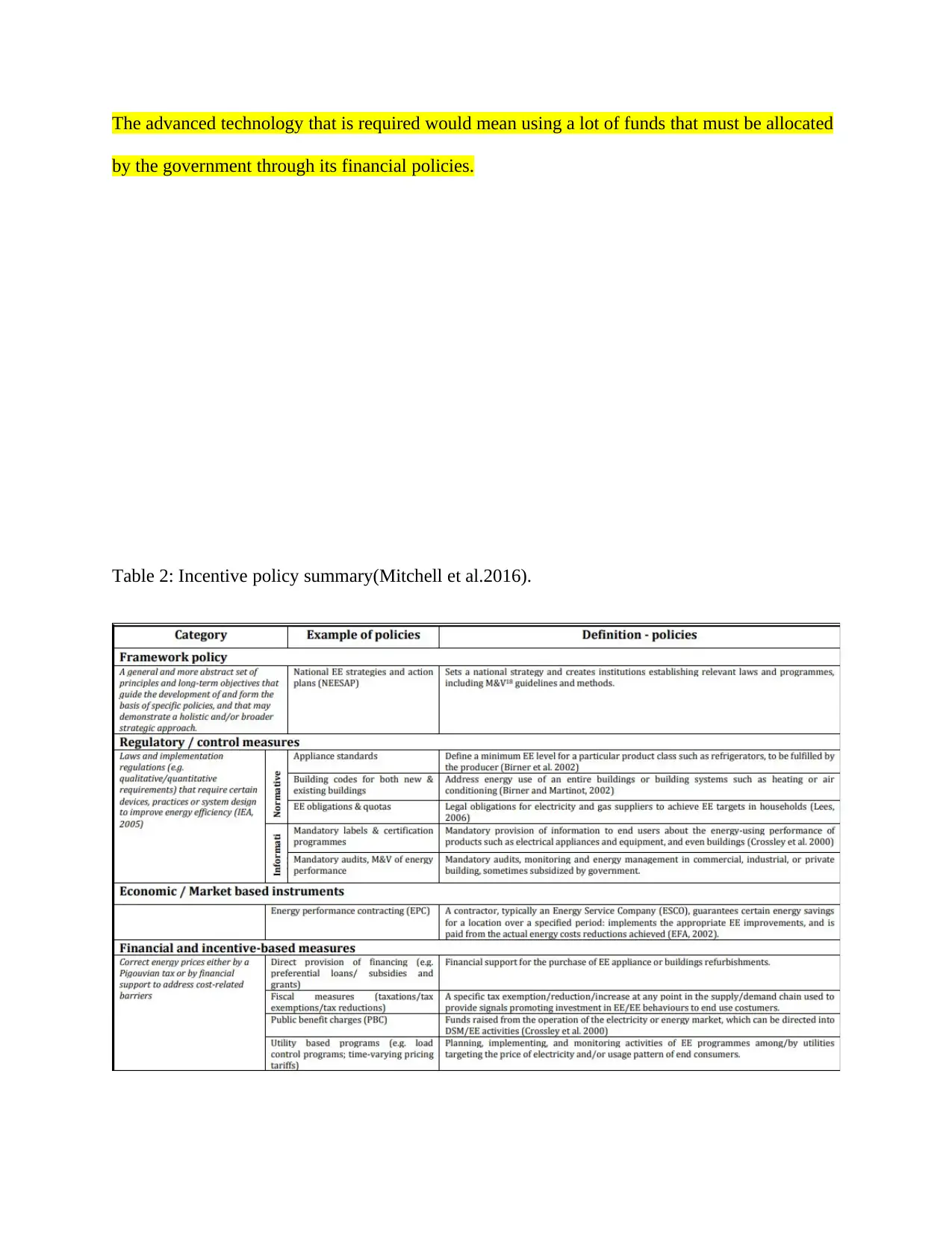
The advanced technology that is required would mean using a lot of funds that must be allocated
by the government through its financial policies.
Table 2: Incentive policy summary(Mitchell et al.2016).
by the government through its financial policies.
Table 2: Incentive policy summary(Mitchell et al.2016).
⊘ This is a preview!⊘
Do you want full access?
Subscribe today to unlock all pages.

Trusted by 1+ million students worldwide
1 out of 15
Related Documents
Your All-in-One AI-Powered Toolkit for Academic Success.
+13062052269
info@desklib.com
Available 24*7 on WhatsApp / Email
![[object Object]](/_next/static/media/star-bottom.7253800d.svg)
Unlock your academic potential
Copyright © 2020–2025 A2Z Services. All Rights Reserved. Developed and managed by ZUCOL.





